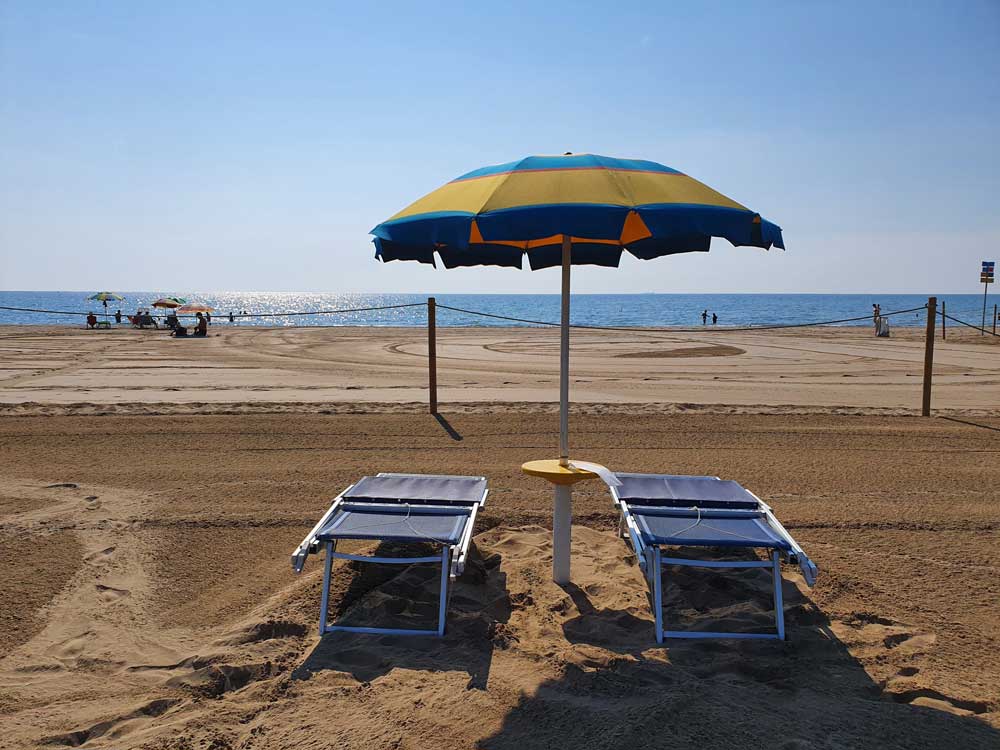About the Lido
Venice Lido (Lido di Venezia) is an island, usually just referred to as ‘the Lido’. It is the narrow strip of land which separates the central part of the Venetian lagoon from the Adriatic Sea. Once just a natural barrier, the Lido is now Venice’s seaside. It’s also the origin of the word ‘lido’ as used in the English-speaking world to describe bathing establishments. The island was developed as a seaside resort at the beginning of the twentieth century, and has been popular for beach holidays ever since.
The Lido is Venice, yet not Venice. For residents, it’s a compromise between the practical mainland and the historic city. The atmosphere on the Lido is very different from Venice: there are leafy residential avenues, roads, cars, cyclists and pavements. Out of season it feels ‘normal’, with reasonably-priced shops and restaurants, and locals taking their children for walks. There are lovely views over the lagoon to Venice, and in winter and spring you may be lucky enough, on a clear day, to see the snow-capped summits of the Dolomites behind the city’s towers and rooftops. As summer approaches, the island’s hotels open for the season, streams of beach-goers cross from the lagoon-shore ferry stop, and there are ice-cream shops on every corner.
Even if you’re not staying on the Lido it makes a good day out, for relaxing on the beach or taking a stroll to admire the ‘Liberty-style’ architecture. I like to head here on sunny winter days too, for a long walk on the beach in the bracing sea air, to clear my head and feel space around me as a break from Venice’s narrow lanes.
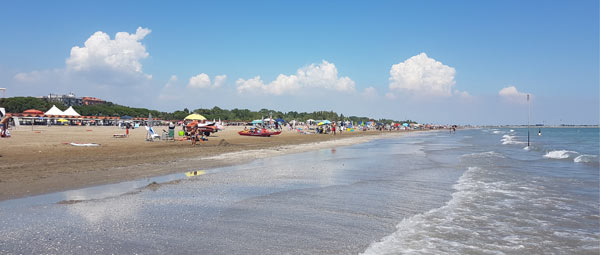
Staying on the Lido
On the Lido you’ll a variety of accommodation, though this tends towards large hotels popular with families and groups, rather than romantic hideaways. The decadent elegance of the early twentieth century has not quite vanished; a few of the smart historic hotels offer a taste of stylish nostalgia. The Grande Albergo Ausonia e Hungaria, the most fabulous building on the Gran Viale, has been sympathetically restored while Hotel Excelsior offers a modern-day grand hotel experience in Moorish splendour by the sea.
The Lido, luxury hotels excepted, is generally cheaper than Venice, with especially good deals if you avoid the peak summer months. I’ve stayed at Hotel Atlanta Augustus, in a central but quietly-located historic villa, with reasonable prices. In winter, though, note that many places close, and the boat trip across the lagoon can be quite cold.
> Find a hotel, B&B or apartment on the Lido.
Beaches
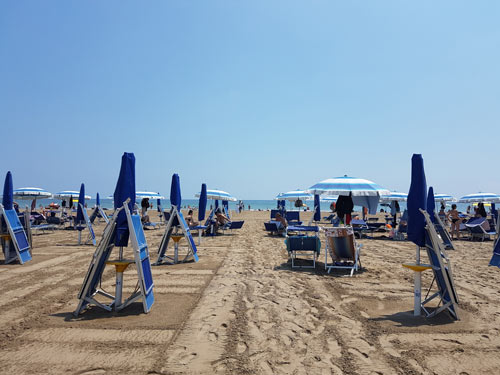
Most visitors to the Lido are here for its beaches. Long, wide and sandy, the Adriatic-facing beaches here may not be the most glorious in Italy but they are among the best for miles around, and they satisfy thousands of sun-worshippers every summer. The Lido’s beaches are mostly lined with beach huts and sunbeds belonging to hotels or private beach concessions where you can pay for sunbeds. If you don’t want to spend money, there is also some free beach – spiaggia libera – where you can turn up with your towel and lie on the ground. The most convenient stretch, although it gets crowded, is at the end of Gran Viale Santa Maria Elisabetta, the street that crosses the island from the vaporetto stop. The ‘Blue Moon’ complex designed by architect Giancarlo De Carlo offers access to the the sand, with a bar, buffet and a shop. There are paying beach facilities here but also expanses of ‘free’ beach – at the time of writing these are under threat, but you will still find large areas where visitors lay their towels out; ask locally if in doubt.
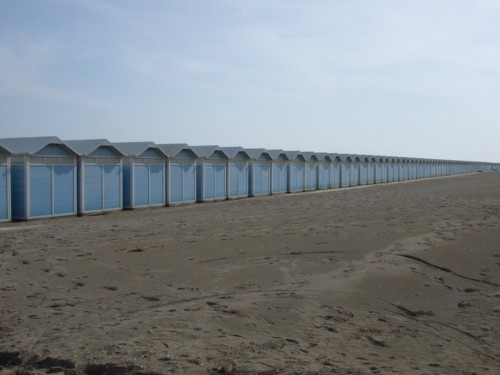
Many local people and regular visitors head towards the two extremities of the island for free beach or a quieter atmosphere. To the south, among the dunes at Alberoni, is a naturist beach. But for tourists visiting for the day, it’s more practical to stay in the popular area near the Gran Viale. To the left as you approach the sea you’ll find a couple more beach establishments along Lungomare D’Annunzio including one of the three beaches run by Venezia Spiagge (Blue Moon is another) where you’ll find a good range of facilities and a more civilised atmosphere than the free beach. Prices to rent sun-loungers and parasols are quite high, but there are generally discounts if you arrive from 3pm onwards. In the links panel (right) you can click to see the latest prices.
The beach surface is gravelly sand and crushed seashells, with the texture and proportion of shells and seaweeds varying along the beach’s length according to currents. Although the private areas are raked, the tide isn’t adequate for scouring the surface, so the popular areas of free beach aren’t always terribly clean. This isn’t the picturesque playing-in-the-sand experience of a UK beach holiday, this is very much a Mediterranean set-up of sunbathers in rows, and young adults larking about in the water. There are no pretty views, although you’ll see large ships out in the Adriatic and maybe a cruise ship passing through the lagoon entrance.
Spending a few hours on the beach or in the sea is an excellent way to take a break from city sightseeing. On a hot day the cooling effects of a sea breeze, a parasol and a dip in the sea are rejuvenating and enjoyable. Even outside the hottest months, a stroll along the sand is still a pleasant contrast to the narrow lanes and confined spaces of Venice.
Useful vocabulary:
> Ombrellone – beach umbrella/parasol. You can usually rent one for the day, week or longer, with a supplement for each sun-lounger
> Lettino – sun-lounger
> Camerini – changing cabins
> Giornaliera – daily
History and tourist sights
Although there is a church with ancient origins on the island, the Lido doesn’t appear much in the history of Venice. Geographically it was a crucial part of the lagoon system which protected Venice, but the Venetians left the island mostly undeveloped as a long sandy bar, useful for anchoring ships and quartering armies. It is possible that the Lido once had greater significance: traditionally the original chief settlement of the lagoon was said to have been Malamocco. A modern settlement of that name sits on the southern part of the Lido, but hazy historical traditions suggest that the original Malamocco was lost to the sea, perhaps even being an Adriatic island.
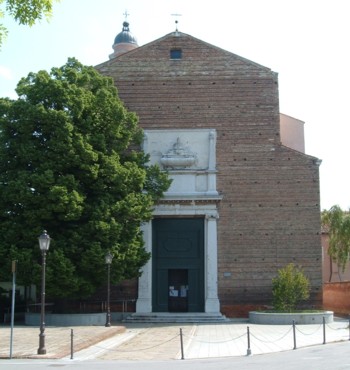
The most important historical monument that is actually visible is in the north of the island, facing over the lagoon. This is the Chiesa di San Nicolò di Lido, a once-important church dating to the eleventh century. For some time the Venetians claimed it housed the body of St. Nicholas, attempting to ignore the much stronger claims of the people of Bari. The building is rather low-key now, although the church’s environs come alive once a year for the annual Festa della Sensa, a symbolic marriage ceremony between Venice and the waters.
Venice’s historic Jewish and Protestant graveyards were on the Lido; the Jewish one can still be visited on tours organised through the Jewish Museum. The gated entrance is on the main road along the lagoon shore between the vaporetto stop and the church of San Nicolò. The Protestant Cemetery was dismantled when a small airfield was built; some of the gravestones are stacked in the Jewish Cemetery; that of Canaletto’s patron, British Consul Joseph Smith, is now in Venice’s Anglican church. Later Protestant burials are on Venice’s cemetery island, San Michele.
Byron and Shelley used to go horse-riding on the Lido’s dunes; a few decades later it would have been unrecognisable to the poets. The advent of seaside holidays turned the Lido into an elegant playground for hotel developers and well-off holidaymakers. Grand hotels were erected along the shores; extravagant examples of what Italians call ‘Liberty’ style. The Lido became a popular place to live, a building site for individualistic villas and apartment blocks which offered a more comfortable modern way of life than the crumbling buildings of Venice. Nowadays the hotels have lost some of their sheen and prestige, but several of the old majestic establishments are still surviving. The Venice Film Festival brings a bit of glamour and vigour to the Lido every year, although the Casino which stood alongside has now closed down.
Architecture
Some of the island’s early twentieth-century architecture is worth a trip to admire. It’s a world away from Venice; although some of the free-standing Gothic-style villas take their cues from Venetian traditions, they do so in their own distinctive style. The Lido is now famed for its examples of stile Liberty, Italian Art Nouveau, named after the London shop.
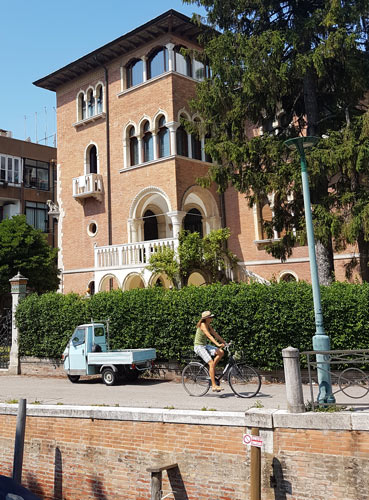
A good place to see some of these elegant villas with their floral, nautical or Venetian-inspired embellishments is along the Gran Viale Santa Maria Elisabetta (look up at the buildings on either side, and don’t miss the fish details on top of a left-hand façade as you reach the sea), and up Via Lepanto and the canals beyond. Among the most imposing buildings are the three grandest hotels. Between the vaporetto stop and the Adriatic shore, on Gran Viale Santa Maria Elisabetta, is the restored and renamed Grande Albergo Ausonia & Hungaria. This is a giddy Art Nouveau treat, with curves, gilded tiles and an elaborate decorated façade.
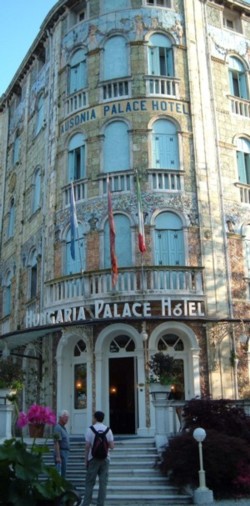
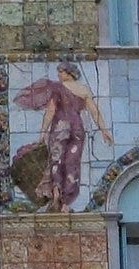
The Hotel des Bains (now apartments) overlooking the sea is a more restrained and majestic building in a neo-classical style where until a few years ago guests could still try to re-live that Death in Venice seaside languor (see below for more about the film). Further south along the seashore is the rather entertaining Excelsior, a riot of Moorish and Venetian influences.
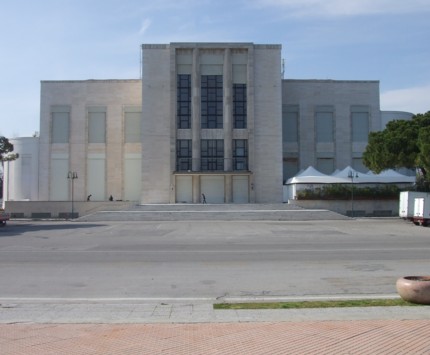
In stark contrast to the extravagant Excelsior are the modernist 1930s Fascist-era buildings alongside. The Palazzo del Cinema (with a fussier 1950s extension) sits shabbily among parked cars until the late summer, when it livens up with flags, temporary façades and film-stars for the Venice Film Festival. Next door is the former Casinò, which transferred its operations to the Grand Canal.
Shops and food
The Lido’s main thoroughfare for shops and restaurants is the Gran Viale Santa Maria Elisabetta. Along the street you’ll find a small supermarket, a beauty store, shoe shops, beach and souvenir stands and tourist-standard restaurants. You can generally eat more cheaply on the Lido than in central Venice, although the standard reflects the fact that restaurants here are aimed at holidaying families.
Part-way along the street after you’ve alighted from the ferry, on the right, is the pedestrianised junction with Via Lepanto. This is an attractive little hub of shops and bars patronised by locals, and outdoor seating near a friendly little Lion of St Mark. A little further up the street, by a canal, is the Osteria al Mercà (via Dandolo 17), a popular bar and eatery (from cicchetti to seafood meals) based in the old fish market, where you’ll still see marble tables used for displaying the catch.
On recent visits my favourite destinations have included Fabio’s (Gran Viale S. M. Elisabetta 61, seawards end of street), which serves and delivers take-away pizzas and pizza rolls – a good choice for a light beach lunch, with a wide range of flavours made with organic ingredients. Nearby is a summer-only pavement kiosk where you can buy fruit smoothies, granitas and alcoholic drinks made with fresh fruit while you wait.
Lido transport: boats, buses and exploring by bike
The Lido is about twenty minutes by vaporetto (waterbus) from the St Mark’s area of Venice. The 1 is a slow, stopping service which starts at Piazzale Roma, runs the whole length of the Grand Canal, then crosses the lagoon to the Lido. The 5.1 and 5.2 are circular services (the same route in opposite directions) which stop at the Lido and go around the outside of Venice. There are other less frequent seasonal services too, such as the 18 which connects the Lido with the islands of Sant’Erasmo and Murano. Larger ferries head along the outer edge of the lagoon to Burano. There is an Alilaguna boat service from Marco Polo Airport.
The area around the vaporetto stop and the Gran Viale is bustling, with shops, restaurants, hotels and beach all close together. The area around the Hotel Excelsior and the Palazzo del Cinema is within walking distance, but one of the Lido’s bus services will save your legs (bus stops are by the vaporetto quays). During the Film Festival there are extra boat services. To explore the southern rim of the lagoon, bus number 11 will take you right along the length of the Lido, and over by car-ferry to Pellestrina, the next long thin island. From here the service continues via passenger ferry to the fishing town of Chioggia. Read more about the unusual journey on the number 11.
Cycling is a popular way to get around on the Lido, and there are a couple of shops where you can hire bicycles on the Gran Viale – take an ID document to use as a deposit. The roads are fairly quiet on the Lido, and you can get off them to cycle along paths and the sea wall. If you have time and energy, you can explore the whole length of the island by bicyle, seeing the views along the sea wall, the various settlements, beaches and dunes, overgrown forts, the golf course and the ferry over to Pellestrina. The really enthusiastic cyclist can cross by ferry and continue cycling southwards along Pellestrina and even as far as the isolated nature reserve along the sea wall at Ca’ Roman. On the Lido, Malamocco is a pretty destination where you might find refreshments.
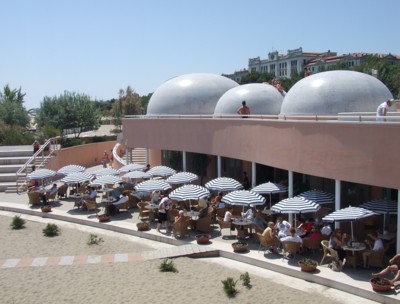
Death in Venice
In Luchino Visconti’s 1971 film Death in Venice, Dirk Bogarde plays ailing composer Gustav von Aschenbach, who visits the Lido during its turn-of-the-century heyday. The film is based on a novella by Thomas Mann, and is set to music by Mahler. Staying in the Hotel des Bains, von Aschenbach muses on mortality and becomes obsessed with a beautiful young boy staying with his family. Meanwhile, over the water, Venice is as unhealthy as the hero. The film has some famous scenes set on the beach of the Lido and in a decaying Venice. You may not wish to emulate von Aschenbach, but if you’re a fan of the film, download some Mahler and listen to it as you explore.
Lido accommodation
> Find a hotel, B&B or apartment on the Lido
On this site
Chioggia, Pellestrina & Ca’ Roman (blog)
Useful external links
Venice Lido hotels, B&Bs & apartments
Venezia Spiagge – paying beaches
